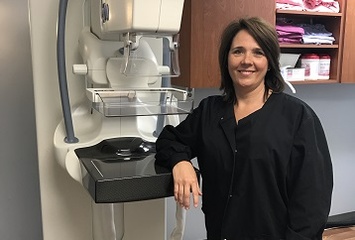Annual mammograms help save women’s lives
Breast Cancer Awareness Month is here, and it’s time to start thinking about getting a mammogram, especially if you have not had one in a while.
While you may not be excited about receiving a mammogram, early detection (screening) may save your life. Why wait until it’s too late? When a problem is caught early, the possibility of surgery is reduced. The option of having 5-6 seconds of mammogram compression to make sure I am cancer free is more appealing than years of worrying if my breast cancer will come back. Mammograms are the screening tool we use to detect breast cancer. The compression is relatively quick and painless, but necessary to properly view breast tissue and has helped to save many lives.
Not all breast cancers are detected by mammography alone. We use ultrasound as another tool to look for cancer. Annual mammograms can detect cancer early, when it’s most treatable. In fact, mammograms show changes in the breast up to two years before a patient or physician can feel them. Mammograms can also prevent the need for extensive treatment for advanced cancers and improve chances of breast conservation. Current guidelines from the American College of Radiology recommend that women receive annual mammograms starting at age 40. Even if they have no symptoms or family history of breast Cancer. Here are a few facts about mammograms. Mammograms have helped reduce breast cancer mortality in the U.S. by nearly 40 percent since 1990. The 10-year risk for breast cancer in a 40-year-old woman is 1 in 69. One in 6 breast cancers occur in women aged 40-49. Three fourths of women diagnosed with breast cancer have no family history of the disease and are not considered high risk. Even for women 50 and over, skipping a mammogram every other year would miss up to 30 percent of cancers.
Dorminy Medical Center uses digital mammography technology. For a routine screening mammogram, which means you do not have any signs or symptoms of breast cancer, we take four views of your breasts. Sometimes additional images are required for certain body types. A diagnostic mammogram is used when you have a lump, breast pain, nodule you feel, or your radiologist recommends extra pictures to make sure that the tissue he’s viewing is normal. On site services are provided by local radiologist Dr. Stephen Thombley of South Georgia Radiology Associates, a group of radiologists who provide services at many area hospitals (see www.southgeorgiaradiology.com for more info). Most biopsies can be done on the same day as a confirmed suspicious finding using ultrasound guidance. These biopsies usually take less than 10 minutes with minimal pain and down time. I hope this information helps with deciding to schedule a mammogram. If you feel anything, make an appointment to see your physician and come see us so we can take care of you. I have so many stories of people who waited too late and some who came in the nick of time and we caught the breast cancer early. Please give us a call at 424-1450 to schedule a mammogram here at Dorminy Medical Center. We will need an order from your physician for a screening or diagnostic mammogram. I am proud to provide our patients with mammography services here at DMC, and I can’t wait to meet you and take care of you.
Caren Greer plays a vital role at Dorminy Medical Center and in the community’s fight against breast cancer. Greer is the hospital’s registered mammographer, a position she has held for almost seven years at DMC. She is passionate about her work and stresses the importance of the early detection that a mammogram can provide. Greer has more than 23 years’ experience. In her spare time, she enjoys horseback riding. She lives in Tifton with her husband and two children.

